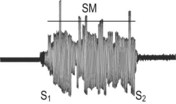21 Ventricular septal defect
Salient features
Examination
• There are normal findings on palpation (there may be either left or right ventricular enlargement).
• With substantial left-to-right shunting and little or no pulmonary hypertension, the left ventricular impulse is dynamic and laterally displaced, and the right ventricular impulse may not be felt. The murmur of a moderate or large defect is pansystolic, loudest at the lower left sternal border, and usually accompanied by a palpable thrill.
• A short mid-diastolic apical rumble (caused by increased flow through the mitral valve) may be heard.
• A decrescendo diastolic murmur of aortic regurgitation may be present if the ventricular septal defect (VSD) undermines the aortic valve annulus.
• Small, muscular VSDs may produce high-frequency systolic ejection murmurs that terminate before the end of systole (when the defect is occluded by contracting heart muscle) (Fig. 21.1).
• If pulmonary hypertension develops, a right ventricular heave and a pulsation over the pulmonary trunk may be palpated. The pansystolic murmur and thrill diminish and eventually disappear as flow through the defect decreases, and a murmur of pulmonary regurgitation (Graham Steell’s murmur) may appear. Finally, cyanosis and clubbing are present.
• The second sound may be normal when the defect is small; A2 is obscured by the pansystolic murmur of large defects. A single second sound indicates that the ventricular pressures are equal and a loud P indicates pulmonary hypertension.
Note: VSD is the most common congenital cardiac anomaly, occurring in 2 per 1000 births. It is a feature of Down syndrome (p. 806).
Diagnosis
This patient has a ventricular septal defect (lesion) of congenital origin (aetiology) and has pulmonary hypertension (functional status).
Questions
Is the loudness of the murmur related to the size of the defect?
No; in fact, very small defects (maladie de Roger) cause loud murmurs (Bull Acad Med, 1879;VIII:1074–94).
Can such defects close spontaneously?
Spontaneous closure usually occurs in a small defect, during early childhood in about 50% of the patients.
Stay updated, free articles. Join our Telegram channel

Full access? Get Clinical Tree



